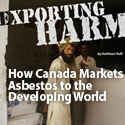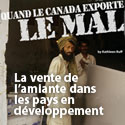Below is an article from the Globe & Mail by Rhéal Séguin.
Cancer risk to town unclear in report on asbestos effects
Opponents and supporters of Thetford Mines operation use findings from health agency study to support their positions
Quebec —Dec. 12, 2009
A report shows that for the people of Thetford Mines, Que., living near an asbestos mine can be hazardous to health, but the jury is still out as to how much of a cancer risk the deadly mineral may be to residents.
Perhaps even more confusing is that both supporters and opponents of asbestos mining are using the study to further their respective causes.
In a report released yesterday, the Quebec Public Health Institute warned that the cancer risk outlined in the study should be interpreted with “caution” because of the “uncertainty and methodological limits” in determining the presence of asbestos fibres in the air. “These uncertainties could lead to an overestimation or an underestimation of the calculated risks, which are difficult to quantify,” the report states.
But the authors of the study were quick to add that while they didn’t want to “pass judgment” on what should constitute an acceptable cancer risk, they underscored the World Health Organization’s assessment that “there was no proof of any safe level regarding the cancer effects of asbestos and that an increased risk of cancer has been observed in populations exposed to very weak concentrations of asbestos.”
Thetford Mines, which was founded on the mining of asbestos, proved to be no different. The risk of lung cancer and mesothelioma in the town was estimated to be 17 times higher than normal, largely because of the higher concentration of indoor and outdoor airborne asbestos found in the community.
Thetford Mines Mayor Luc Berthold said that the study showed that residents can now “breathe easier.” He noted that when comparing the study’s figures with other statistics, Thetford Mines would, over a 35-year period, have 1,000 deaths from tobacco-related lung cancer and 100 deaths from traffic accidents but only one from airborne asbestos.
For Clément Godbout, president of the Chrysotile Institute, which defends and promotes the use of asbestos, the study confirmed the “alarmism” promoted by the anti-asbestos lobby. “This report confirms several studies on the low level of risk associated with the low exposure to chrysotile,” Mr. Godbout stated. “It also supports recent scientific data to the effect that at controlled levels of exposure, no measurable risk to health is detected.”
Opponents of asbestos mining argued the exact opposite. For Manitoba NDP MP Pat Martin, who has mounted a campaign against the use and export of the mineral, the study confirms that citizens living near asbestos mines are at grave risk. The “jig is up,” Mr. Martin argued, calling for the asbestos mines to be “sealed.”
“Canada must ban asbestos in all its forms, stop exports and begin measures to help this region of Quebec transition to a different economic base,” Mr. Martin said. “This study underlines the fact that there is no safe level of asbestos exposure.” Many countries have banned asbestos as a health hazard, leaving Thetford Mines with a mineral that fewer and fewer countries are using. The vast majority of the asbestos being mined was being exported to developing countries and used in construction material.The head of the public health agency that conducted the study, Dr. Philippe Lessard, recommended reducing activities around asbestos mine residues to avoid stirring up dust containing the fibers.



Sat, Dec 12, 2009
Misc.